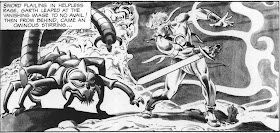Dark Horse / New Comic Company
2013
'Creepy Presents: Steve Ditko' (New Comic Company / Dark Horse Books, August 2013) is the latest in the Eerie Presents / Creepy Presents series.
(Previous volumes are Creepy Presents: Bernie Wrightson, Eerie Presents: Hunter, Creepy Presents: Richard Corben, and Eerie Presents: El Cid).
Like others in the series, the book is a quality, hardbound collection of comics originally appearing in Creepy and / or Eerie in the 60s, 70s, and early 80s, and an affordable alternative to the $50 volumes of the New Comic Company 'archive' collections for these Warren magazines.
Late in 1965, or perhaps early in 1966 (the exact date is unsure) Steve Ditko (b. 1927) quit working for Marvel, after increasing disagreements with Stan Lee rendered communication between the two men impossible. Ditko began working for other publishers, including Charlton and DC, and did not resume working for Marvel until 1979.
In 1966, Ditko began to work with editor Achie Goodwin at Warren, and over a two-year span he produced 16 strips for Creepy and Eerie. This volume reprints those 16 strips.
As always, New Comic Company's Mark Evanier does a good job with the Introduction, and the reproductions of the comics are of good quality. Ditko's work for Warren included classic horror stories, as well as some fantasy and sword-and-sorcery strips.
Ditko took a varied approach to his illustrative style. Sometimes he relied on pen-and-ink line work, as in 'Collector's Edition' (where he also worked in Zip-A-Tone effects on the bottom-most panels):
But most of his work relied on an ink-wash technique:
With the exception of 'The Sands That Change', a really cruddy effort, the comics that Ditko did for Warren display his skills to good effect.
However, I suspect that most purchasers of 'Creepy Presents: Steve Ditko' will be people over 30 years of age, including Baby Boomers who fondly remember the Warren magazines from their youth.
Ditko's artwork is probably too idiosyncratic to draw much attention from younger comics fans, who have been reared on comics composed and colored using PC software. It's increasingly difficult nowadays to find a comic book from any major publisher in which the stippling, shading, or cross-hatching that defined Ditko's approach, is a major part of any draftsmanship.
With the exception of dedicated black-and-white publications, like the so-so reboot of 'Creepy Comics' that Dark Horse has launched, most contemporary readers are going to be familiar with comics that have adopted the aesthetic of line drawings, flat colors, and 'manga' or 'indie' stylings. To them, the visual flavor of the Ditko strips from the 60s may seem strange and unappealing.
If you're a fan of Ditko's unique artwork, then 'Creepy Presents: Steve Ditko' certainly is worth picking up.










No comments:
Post a Comment